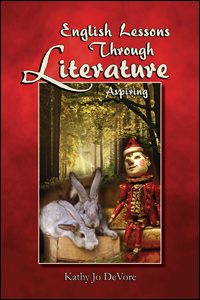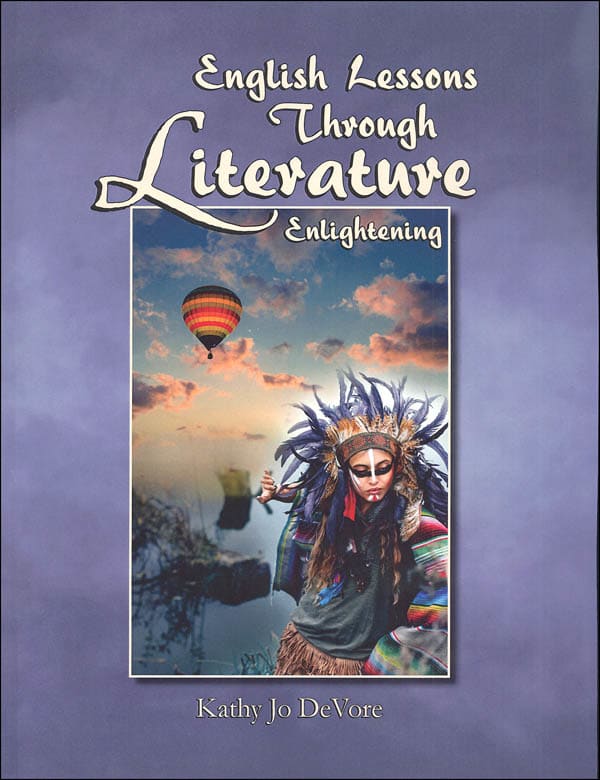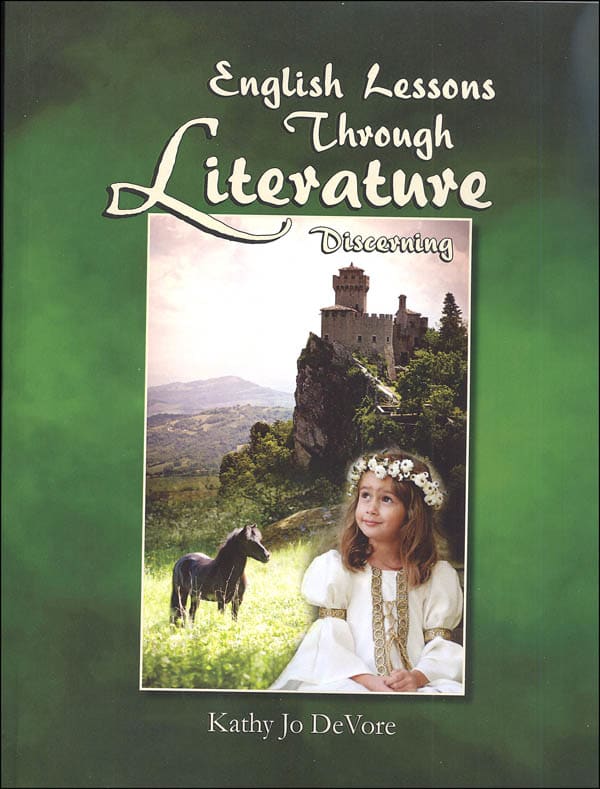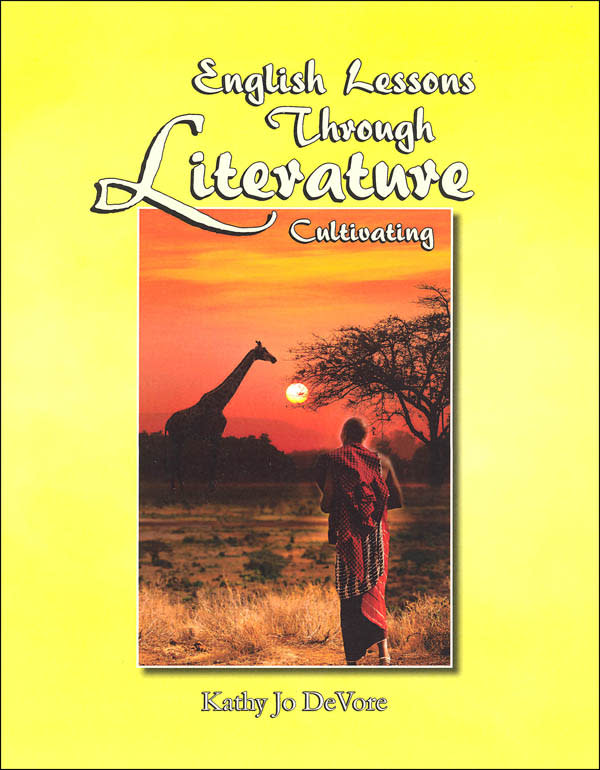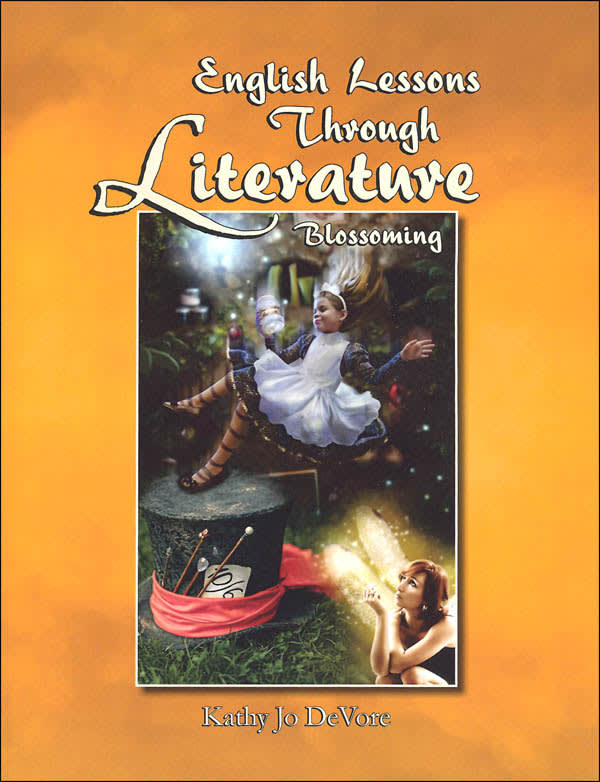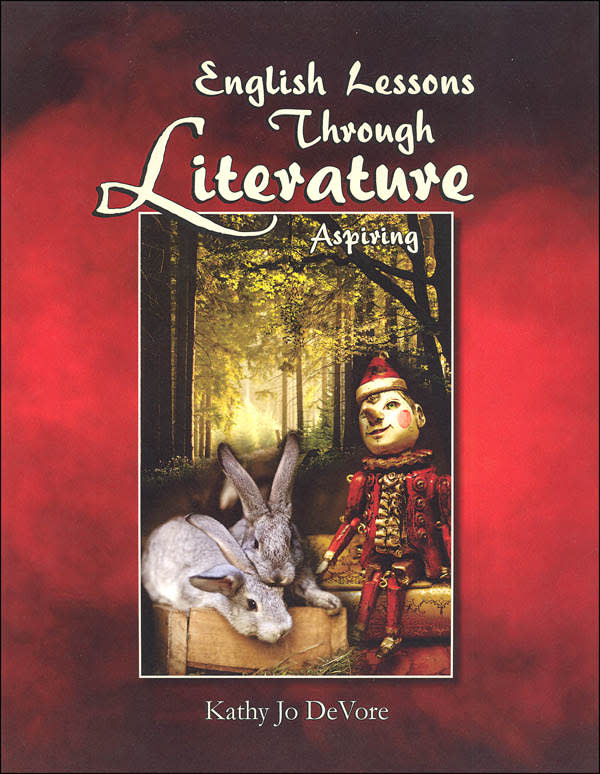English Lessons Through Literature (ELTL) is a language arts program for first through eighth grade (or higher) that uses both Charlotte Mason and classical methods. ELTL primarily covers grammar and composition skills. The series consists of seven levels that are identified by the letters A through G.
One large book serves as the coursebook for both parent and student for each level. (An optional student workbook is available.) Parents will present lessons from the book, but students will also sometimes work from that same book. Older students can probably complete most work on their own directly from the book with less parental interaction. In contrast to most language arts programs, these courses are intended to be taught three days per week rather than every day.
Each level requires you to also have on hand full-length books for reading aloud, but those are all supposed to be available free online. Parents will need to read them aloud until students are at the stage where they can read independently and comprehend what they are reading. Examples of literary works used for each level are:
Level A, Aspiring: The Tale of the Flopsy Bunnies by Beatrix Potter, Just So Stories by Rudyard Kipling, and Pinocchio by Carlo Collodi
Level B, Blossoming: The Wonderful Wizard of Oz by L. Frank Baum, The Wind in the Willows by Kenneth Grahame, and Alice's Adventures in Wonderland by Charles Lutwidge Dodgson
Level C, Cultivating: The Story of Doctor Dolittle by Hugh Lofting, The Marvelous Land of Oz by L. Frank Baum, and The Secret Garden by Frances Hodgson Burnett
Level D, Discerning: Heidi by Johanna Spyri, Black Beauty by Anna Sewell, and The Reluctant Dragon by Kenneth Grahame
Level E, Enlightening: The Adventures of Tom Sawyer by Mark Twain, The Happy Prince and Other Tales by Oscar Wilde, and Around the World in Eighty Days by Jules Verne
Level F, Flourishing: At the Back of the North Wind by George MacDonald, Call of the Wild by Jack London, and Otto of the Silver Hand by Howard Pyle
Level G, Growing: “The Legend of Sleepy Hollow” by Washington Irving, “The Raven” by Edgar Allan Poe, The Black Arrow by Robert Louis Stevenson, and Northanger Abbey by Jane Austen
Within the course books, Aesop's Fables are used frequently in all levels along with the fiction, non-fiction, and poetry from the public domain listed above. While some of the literature seems difficult or archaic, many homeschoolers have found that children understand surprisingly well, and their vocabulary and reading skills advance rapidly by exposure to challenging literature. While parents will have to discuss the meaning of unfamiliar vocabulary words, the mix of real books, Aesop's Fables, poetry, and other, sometimes unusual, literary selections balances out fairly well so that the content is interesting and even fun to read. In contrast to most of the literature, DeVore's instruction on grammar is written simply and directly to the student in a casual, personal tone. The instruction avoids the sometimes flowery language that has been used in earlier books presenting Charlotte Mason-style language lessons.
In Level A, rather than traditional workbooks, ELTL uses copywork, narration, dictation, and picture study as children work with poems, Aesop's Fables, fiction books, and reproduced pictures of works by famous artists. Narrations in the first half of Level A are picture narrations—you will first read one of Aesop's Fables to your child, and he or she will draw a picture of the fable. Next, the child narrates, telling you about his or her picture. Each day's lesson includes an excerpt from literature to be read aloud, a poem, and either an Aesop's Fable or a reproduced artwork for picture study.
Picture study differs from the initial picture narrations. Beginning even in Level A, students study pictures of artworks. Some discussion-generating questions are included for each picture. These include broad, general questions such as, "Describe the picture," so that children can narrate to you what they see and think about each picture. Pictures are reproduced in full color in the digital editions while print edition pictures are black and white. Since color images are an important factor when it comes to art appreciation, De Vore provides free color copies of the art through her Lulu store.
The second half of Level A begins standard narrations. For these, you read the fable aloud, then your child retells the story in his or her own words while you write it down. If your child is verbose, this can be challenging. You might have to experiment with ways to take a shorthand version of the child's retelling, record and transcribe it, or come up with some other way to capture their ideas accurately. Some children might need prompting with leading questions, so DeVore offers suggestions for those in the introduction to each book. In Level B, you will write a portion of your child's narration for him or her to use as copywork. Children begin to write their own narrations in Level C, although they continue to do some oral narrations.
In the primary grades, children learn many aspects of grammar and correct usage simply through exposure to the literary works and their own copywork. Copywork in ELTL is taken from literature, maxims, and poetry. Spelling and many aspects of grammar and usage are learned through the dictation exercises and copywork. However, some direct instruction is also included. At the beginning of a lesson, just after reading the literary selection, a new grammatical concept is usually taught using a sample sentence from the literature. Children begin some written grammar exercises in Level C. Rather than pre-written exercises, students either copy sentences into a copybook then mark them as directed, or else they can complete these activities in the optional workbook. Sentence diagramming, introduced in Level C, is an element more commonly found in classical programs than in Charlotte Mason style programs. Diagramming instruction continues through all levels from this point on. Some memory work for grammar rules is included at the end of each book for you to use if you wish.
Most of the example sentences used for instruction and some of the copywork are drawn from the literature, so it is best if a parent reads the literature assignment before beginning each lesson. Some of those sample sentences have been simplified for diagramming, and some changes have been made in spelling and punctuation in line with current usage.
Students in Levels D through G (as well as the future Level H) begin composition work by imitation as in the progymnasmata, a classical approach. They learn to outline their compositions and develop skills for writing different types of compositions. Older students begin to work with historical and scientific narratives in addition to the literature. Students continue to work from models in Levels D and above rather than coming up with their own topics. However, activities based on the progymnasmata have students work creatively from those models, in effect, using models as springboards from which to develop their skills for original writing.
While Levels A through G are recommended for grades one through seven, they might be used a year or more later. Series author Kathy De Vore actually used them a year later with her own children. A child who has already learned to read and write in kindergarten should be able to start in Level A. If you have an older student (fifth grade or above) who has had little exposure to grammar, you might want to start with Level D because it paces grammar instruction at an introductory level on topics such as indirect objects and sentence diagramming. You might even consider using the first four levels with upper elementary students who have struggled with language arts thus far and need a fresh introduction.
Levels D and beyond build upon one another, so they should be used in sequence. Even more than lower-level courses, each of these courses can be used by students two or more years beyond the corresponding grade levels. This means that you shouldn't be concerned about a student getting behind if you use, for example, Level E with an eighth grader. Remember that the letter designations for levels allow you to use these courses whenever it is best for each student.
Following are some details for each level:
Level A is lighter than succeeding levels. Children learn sentence structure, usage, and vocabulary as they listen to the read-alouds and complete copywork exercises, and they are also taught about capitalization and punctuation. In the second half of the book, children are introduced to nouns, pronouns, verbs, and adjectives.
Level B continues with capitalization, punctuation, and types of sentences. It also introduces the parts of speech, helping verbs, linking verbs, being verbs, contractions, abbreviations, antonyms, synonyms, and homophones. Exercises at this level have children demonstrate an understanding of what they have learned regarding grammar.
Level C adds two dictation exercises each week. Parts of speech and syntax are taught again but with the addition of sentence diagramming. Students will also do some written work as they analyze words, come up with synonyms, rewrite sentences from the story (e.g., turning a declarative sentence into an interrogative sentence), or imitate a descriptive paragraph. In general, the reading and copywork passages are lengthier, and the exercises are more challenging. The grammar is definitely more challenging than what is covered in many other third grade courses since children learn about comparative adjectives, subject-verb agreement, the concepts of person and tense, appositives, and infinitives, as well as how to identify and diagram all eight parts of speech. In preparation for learning to diagram prepositional phrases, students mark prepositional phrases with brackets, a strategy I find very helpful. The optional workbook for Level C includes lines for sentence diagrams, a feature that should make diagramming easier for students.
Level D continues with both oral and written narrations, picture study, grammar (with sentence parsing and increasingly complex sentence diagrams), dictation, and memory work. Grammar instruction is more direct than in earlier levels. Students also do copywork each day in a blank composition book by copying passages from the literary works, model stories, or other sources that a parent might choose.
With Level D, elements of the progymnasmata become more visible as students continually work through a six-lesson (two-week) cycle for each writing lesson. On the first of the six days, students read and orally narrate the model story that will be used as the springboard for the writing lessons. Many of the model stories are from folk tales, but some are non-fiction pieces on science or history. The second day generally assigns a "copia exercise" where students might find synonyms for certain words, condense or expand sentences, change the type of a sentence, substitute synonyms or antonyms, or otherwise play with words and sentences to extend their wordsmithing skills. Alternatively, they might be assigned to write an outline of the model story. The third day is for writing either a literary analysis or a descriptive writing exercise. Another copia exercise is completed on the fourth day. The fifth day specifies copywork be done from the model story. On the sixth day, students write their own narration of the model story from their outline.
Level E continues in the same format as Level D, although the level of difficulty is definitely higher. Both books follow a similar progression with types of writing, even using very similar assignments. For example, in both books, Lesson 78 includes writing a scientific narration. The same introductory information is included for both lessons, but Level E's lesson adds: "Begin your paper with an introduction. This can be background information, an anecdote, a surprising statement or question, a quotation, or an imaginary scenario." This is a good example of the type of incremental learning that takes place in this series.
Level F teaches slant narratives, the in medias res technique (a story that starts in the middle of the action), reverse chronology, biographical sketches, compare and contrast essays, parables, literary analysis, and how to write introductions and conclusions. While some models are drawn from well-known poets and historical narratives such as Great Englishmen by M. B. Synge, most models are taken from Chinese and Japanese fairy tales and legends.
Level G is similar to Level F, although a mixture of American and British literature serves as the source for models. It reviews some of the same composition skills taught in Level F such as reverse chronology, compare and contrast essays, and literary analysis. It continues to teach students to write from models and to rewrite sentences in copia exercises. It introduces two more elements of the progymnasmata: chreia and maxim.
Level H (due summer of 2019) has this brief description: "The stories in Level H will be Jewish stories from the Talmud and Midrash, Zen Buddhism stories, and Christian parables; these will be included as literature, rather than as devotional texts, to promote cultural literacy."
Summary
While the fables and literary works used in English Lessons Through Literature often teach virtues and positive character traits, these courses are secular in approach. A Bible Supplement (available either as a free download or as a printed book for $10) has Bible verses for copywork or dictation.
Lessons are simple to follow using instructions within each book. There are no answer keys for Levels A and B, but answers are obvious or easy to determine. Levels C and above have answer keys for the exercises at the back of the book.
All books (texts and optional workbooks) are available as either print or downloadable PDFs. (You also have a choice of either four or five different forms of manuscript or cursive models for the Level A through D workbooks.) The workbooks have copywork models with space for writing, drawing, and all other exercises students would otherwise complete outside of the coursebook. While the workbooks are optional, they do make using the courses easier for both parent and student.
English Lessons Through Literature is a challenging and comprehensive program that retains the hallmarks of Charlotte Mason's methodology while also including some classical methodology. The coverage of grammar, although introduced earlier than Mason recommended, should prove helpful to those concerned about the Common Core and standardized tests.




